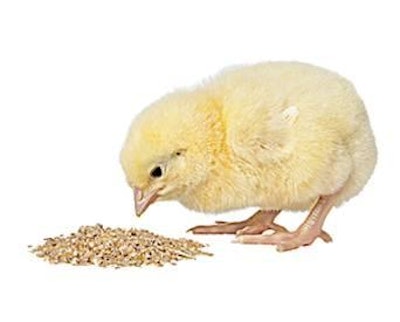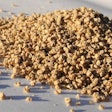
In the poultry feed industry, it is widely acknowledged that inefficient use of dietary protein can be detrimental to the environment. Undigested protein in manure can be converted into undesirable compounds, such as ammonia, nitrate and nitrous oxide. These substances can cause or be contributors to serious undesirable outcomes for both the environment and human health, such as acid rain, loss of biodiversity and global warming.
An additional challenge for the producer is that rising prices for protein-rich ingredients. Recent increases in the price of conventional protein-rich feed ingredients, such as soybean, have significantly increased feed production costs, and such trends are set to continue.
The USDA recently announced, for example, further increases to the 2013/2014 season-average price for soybeans, with a US$0.25 increase to both the lower and upper price per bushel.
Corn, meanwhile, has doubled in price over the last three years, due largely to surging demand from the biofuels industry. Harvest failures and the increasing land price are further augmenting these costs.
Changing the face of feed
To better understand the overall environmental impact of poultry production, research projects are increasingly turning to sophisticated modeling tools, such as Life Cycle Assessment (LCA).
Taking into account a range of variables from across the poultry production supply chain, these tools are capable of calculating best-case scenarios for delivering environmental sustainability without sacrificing industry efficiency or profitability.
The results of LCA modeling have revealed that the delivery of optimum sustainable profitability scenarios is particularly dependent on the composition and efficiency of feeds.
Factors, such as ensuring protein specifications, are set to the correct levels for the genetics of the animals being reared; safety margins are minimized (by reducing the need for such margins); and both highly digestible protein-rich ingredients used in animal feed and an enzyme to enhance feed protein digestibility play important roles.
Enzymes in poultry nutrition
Enzymes are increasingly commonplace in modern feed production, primarily due to their ability to produce feed cost savings and improve nutrient digestibility.
There are now several commercially available feed enzymes used in poultry nutrition, including phytases and carbohydrases, which make up the majority of the feed enzyme market. A recent addition to this group is the mono-component protease.
Increasing the digestibility of amino acids in broilers is an important step in increasing sustainable profitability for feed and poultry producers.
Research, which has demonstrated the effectiveness of a mono-component protease to increase the amino acid digestibility of poultry feeds, has also found that by using the enzyme, amino acid digestibility in broilers can be increased by up to 7 or 8 percent.
Mono-component proteases have been demonstrated to provide a number of benefits which can address core challenges faced in poultry production. Notably, they reduce the requirement for expensive protein-rich ingredients in feed and allow replacement with lower-protein, often locally grown, feed ingredients without loss of performance.
A study published by Angel et al., for example, demonstrated that protease improved bodyweight gain when added to a low-protein corn soy diet. Mono-component proteases can therefore lower feed costs by around EUR0.02 per broiler (even after taking the cost of the enzyme into account).
The introduction of mono-component proteases in feed not only has a substantial impact on profitability, but it also directly contributes to environmental sustainability.
A 2011 LCA study, conducted by Novozymes and DSM, demonstrated that using protease in a reduced protein feed (the typical commercial approach) "can significantly reduce the environmental impact of broiler production in terms of air and water quality." This reduction of dietary protein in feed can lead to 15 percent less nitrogen content in manure and 35 percent less ammonia emission.
The study highlights the significant impact proteases can have on environmental sustainability when used with low protein diets. The potential magnitude of mono-component proteases if used in the diet of all broilers is substantial -- it could reduce nitrogen production by 32,000 metric tons per year in the U.S. alone.
Another key consequence of using a mono-component protease is that less land is needed by producers to dispose of manure from rearing broilers.
This is particularly important in those areas of the world faced with a restriction on the amount of nitrogen that can be applied per hectare of land. With less nitrogen excretion per broiler, less land is required for the disposal of its manure. For instance, in Europe, around 80,000 hectares less land would be needed to raise the same number of broilers as produced today.
Put another way, an extra 310 million 2.5 kg broilers could be produced in Europe each year without the need for any extra land to dispose of the manure produced. Environmentally and profitability speaking, this is a hugely exciting opportunity.
Animal health is also a central focus of research into the potential benefits of feed enzymes.
Mono-component proteases have been shown to reduce the nitrogen content in the gastrointestinal tract. This can lead to a reduction in the level of substrate available to pathogenic bacteria, which in turn can benefit animal health and food safety.
Birds also drink less water when there is less nitrogen in their diet, which has been proven to improve litter quality in the broiler house. The improvement in litter quality can, in turn, reduce the severity and incidence of footpad dermatitis. As well as improving the welfare of the broiler flock, the increased animal health status and performance also results in increased profitability for the poultry producer.
A sustainable future
The opportunities made possible by a mono-component protease have the potential to radically change the role of the feed industry in supporting poultry producers to combine environmental improvements with cost-saving benefits.
Its importance to the feed industry can be reflected by its prominent growth in the feed enzyme market. Making up just 5 percent of the global feed enzyme market in 2012, protease's market share is forecasted to rapidly grow, with a compound annual growth rate of 7.2 percent between 2013 and 2018, as producers become more aware of the benefits it offers. For the agriculture sector, this enzyme could hold the key to delivering real environmental improvement, while also reducing costs.






